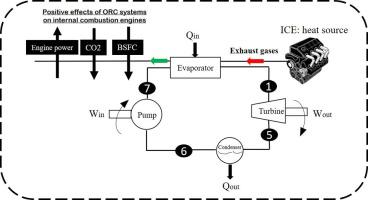Energy Conversion and Management ( IF 10.4 ) Pub Date : 2021-01-22 , DOI: 10.1016/j.enconman.2021.113828 Fuhaid Alshammari , Mohamed Elashmawy , Mohamed Bechir Ben Hamida

|
This paper outlines a comparative assessment of the effects of various fluid types on the performance of powertrain performance (i.e. heavy-duty diesel engine + organic Rankine cycle) and the design of the radial inflow turbine. The considered organic fluids are R123 (dry), R21 (wet) and R141b (isentropic). The exhaust gas of a 7.25ℓ heavy duty diesel engine is utilized as the system heat source. The powertrain system, including the radial inflow turbine, is analyzed under superheated conditions and near saturated vapor curve, at various operating conditions. Surprisingly, wet fluids offer attractive cycle performance in the superheated region (12.65% on average) followed by isentropic fluids (12% on average). Near the saturated vapor curve, isentropic fluids are found to present best cycle performance (13.77% on average) while wet fluids offer the lowest (10.90% on average). However, wet fluids present a compact turbine design and best isentropic efficiency with an average value of 82% in the superheated region. Near the saturated vapor curve, isentropic and dry fluids offer relatively lower turbine efficiencies (80.9% and 80.3 on average) while wet fluids result in two-phase condition at the turbine exit which results in poor turbine performance (63.30% on average). Moreover, R141b shows best improvements of engine power and BSFC with values of 11.18% and 10%, respectively, at 1 kg/s. Compared to R123 and R141b, R21 improved the engine power and BSFC by at least 7.86% and 7.63% under superheated conditions.
中文翻译:

使用7.25 on重型柴油机的实验数据,工作流体类型对动力总成性能和涡轮设计的影响
本文概述了各种流体对动力总成性能(即重型柴油发动机+有机朗肯循环)性能的影响以及径向流入涡轮机设计的比较评估。考虑的有机流体为R123(干),R21(湿)和R141b(等熵)。7.25 source重型柴油机的废气用作系统热源。包括径向流入式涡轮机在内的动力总成系统在各种工况下的过热条件和接近饱和蒸汽曲线下进行了分析。出人意料的是,湿流体在过热区域(平均为12.65%)具有诱人的循环性能,其次是等熵流体(平均为12%)。在饱和蒸汽曲线附近,等熵流体被发现表现出最佳的循环性能(13。平均为77%),而湿流体的最低(平均为10.90%)。但是,湿流体呈现出紧凑的涡轮设计和最佳的等熵效率,在过热区域的平均值为82%。在饱和蒸汽曲线附近,等熵和干流体提供的涡轮效率相对较低(平均分别为80.9%和80.3),而湿流体导致涡轮出口处出现两相状态,从而导致涡轮性能不佳(平均63.30%)。此外,R141b以1 kg / s的速度分别显示出11.18%和10%的发动机功率和BSFC的最佳改进。与R123和R141b相比,R21在过热条件下的发动机功率和BSFC至少提高了7.86%和7.63%。湿流体呈现出紧凑的涡轮设计和最佳的等熵效率,在过热区域的平均值为82%。在饱和蒸汽曲线附近,等熵和干流体提供的涡轮效率相对较低(平均分别为80.9%和80.3),而湿流体导致涡轮出口处出现两相状态,从而导致涡轮性能不佳(平均63.30%)。此外,R141b以1 kg / s的速度分别显示出11.18%和10%的发动机功率和BSFC的最佳改进。与R123和R141b相比,R21在过热条件下的发动机功率和BSFC至少提高了7.86%和7.63%。湿流体呈现出紧凑的涡轮设计和最佳的等熵效率,在过热区域的平均值为82%。在饱和蒸汽曲线附近,等熵和干流体提供的涡轮效率相对较低(平均分别为80.9%和80.3),而湿流体导致涡轮出口处出现两相状态,从而导致涡轮性能不佳(平均63.30%)。此外,R141b以1 kg / s的速度分别显示出11.18%和10%的发动机功率和BSFC的最佳改进。与R123和R141b相比,R21在过热条件下的发动机功率和BSFC至少提高了7.86%和7.63%。平均3),而湿流体导致涡轮出口处处于两相状态,导致涡轮性能较差(平均63.30%)。此外,R141b以1 kg / s的速度分别显示出11.18%和10%的发动机功率和BSFC的最佳改进。与R123和R141b相比,R21在过热条件下的发动机功率和BSFC至少提高了7.86%和7.63%。平均3),而湿流体导致涡轮出口处处于两相状态,导致涡轮性能较差(平均63.30%)。此外,R141b以1 kg / s的速度分别显示出11.18%和10%的发动机功率和BSFC的最佳改进。与R123和R141b相比,R21在过热条件下的发动机功率和BSFC至少提高了7.86%和7.63%。



























 京公网安备 11010802027423号
京公网安备 11010802027423号